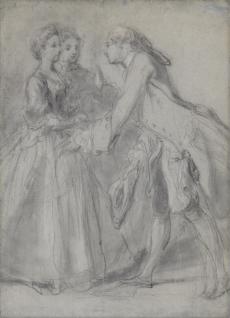


Gravelot was arguably the greatest book illustrator in both France and England in the 18th century. He played a vital role in introducing some of the grace and lightness of the French Rococo into English art during his time in England. Younger son of a master tailor and brother of the celebrated geographer and cartographer Jean-Baptiste Bourguignon d’Anville (1697-1782), he drew from the very first, but made a bad start. He spent the money that should have taken him to Rome on books and riotous living, following which his father exiled him to Santo Domingo. Little more resulted from that than a map of the island. On his return to Paris in 1729, however, he took up art in earnest, studying first under Jean II Restout (1692-1768) and then François Boucher. In 1733 he was invited to England by the émigré engraver and publisher Claude Du Bosc (1682-1745). He stayed until 1745, when he was driven back to Paris by the anti-French feeling that prevailed after the British defeat in the Battle of Fontenoy.
In Gravelot’s 12 years in England, his work was much in demand; he provided, for example, 31 compositions for Lewis Theobald’s Works of Shakespeare (1740), as well as etching 31 plates after Francis Hayman (1708-1776) for his edition of 1744-1746, and made 29 illustrations for Samuel Richardson’s Pamela (1742). Back in France, he was equally productive: in the course of his career, he produced the original drawings for almost 2000 book illustrations, as well as himself making numerous prints. The largest holding of these is amongst the 106 drawings in the Pierpont Morgan Library in New York. The present drawing is different in scale and character to any of those. It is one of a limited group, other examples of which include three in the Louvre; whilst there are three comparable drawings of single figures in the British Museum, another three in the Ashmolean Museum in Oxford, and others have been sold at auction.
The Goncourt Brothers’ drawing Les Visites, in the Louvre, was one of four such drawings of groups and two of single figures that the brothers had acquired, which they described as ‘grandes études d’hommes & de femmes, dans le goût de certaines études habillées de Boucher, mais d’un dessin plus serré, plus correct, plus près de la nature, & qui ressemblaient à de coquettes académies de poses & de costumes’. The drawings are on a scale to have been done as studies for paintings, but paintings by Gravelot are exceedingly scarce, being limited to the two versions of A Man Reading to a Woman in an Interior (York City Art Gallery and Twickenham, Marble Hill House; one of which was engraved by René Gaillard [c. 1719-1790] as Le Lecteur), the major part of Captain the Hon. Augustus John Hervey being Greeted by his Family in Paris (Bury St Edmunds, Ickworth House), and one or two sketches for Francis Hayman’s large paintings for the supper-boxes at Vauxhall. Two of the Louvre’s three drawings are also squared up as if for transfer to a painting; but in composition La Lecture is intriguingly close to the scene that Gravelot designed as the headpiece engraved by George Bickham for his The Adieu to the Spring Gardens.
This hints at one of the surprises of these drawings: that – though only one case of the specific use of one of them has so far been identified (that of one of the Goncourt drawings, which was squared up to prepare for its reduction to a smaller size, to be engraved for the French translation of Henry Fielding’s novel Tom Jones in 1750) – they were actually made as studies for engravings, most probably book illustrations, on a much reduced scale. As Edmond de Goncourt explained the process, Gravelot, ‘cherchait d’abord d’après nature, ou d’après des mannequins articulés qu’il avait fait exécuter à Londres, dans de larges dessins au crayon noir rehaussés de blanc, et tout semblables à des études de Lancret. Cela fait, il les mettait au carreau, puis les réduisait en de petits dessins du format des livres, exécutés à la mine de plomb avec le plus grand fini.’ That such artificiality – the use of articulated lay-figures, squaring-up and reduction – should have resulted in illustrations of unprecedented naturalness is quite remarkable. The fact that the present drawing was not squared up, however, would appear to indicate that it was never thus reduced to result in an engraving.
He was a French illustrator, engraver, draughtsman and painter. He changed his name from Bourguignon to Gravelot; his brother, Jean-Baptiste Bourguignon d’Anville, was a distinguished geographer and cartographer. He studied under François Boucher, and from 1733 to 1745 he lived in London, where he played a central role in introducing the Rococo style into British book illustration and design, thus greatly influencing contemporary taste. Thomas Gainsborough was his pupil.